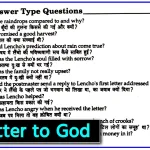What is the central theme of “A Letter to God”?
The central theme of “A Letter to God” is faith and hope. The story highlights the unwavering belief of Lencho in God and how he trusts divine intervention for his problems.
Who is the main character in “A Letter to God”?
The main character in the story is Lencho, a hardworking farmer who depends entirely on nature for his livelihood.
Why does Lencho write a letter to God?
Lencho writes a letter to God because his crops are destroyed by a hailstorm, and he needs financial help to sustain his family.
How does Lencho address God in his letter?
Lencho writes to God with deep faith and respect, asking for 100 pesos to overcome his financial crisis.
What does Lencho request in his letter?
Lencho asks God to send him 100 pesos so that he can survive after his crops are destroyed.
How do the post office employees react to Lencho’s letter?
The post office employees first laugh at Lencho’s innocence but later feel touched by his faith. They decide to collect money and help him.
How much money do the post office employees collect?
The employees manage to collect 70 pesos and send it to Lencho, as they could not gather the full amount he requested.
Why does Lencho become angry after receiving the money?
Lencho becomes angry because he receives only 70 pesos instead of 100. He believes that the post office employees must have stolen the rest.
What does Lencho do when he receives less money?
Lencho writes another letter to God, asking Him not to send the money through the post office, as he thinks the employees are dishonest.
What message does the story convey?
The story conveys the idea of unwavering faith, human kindness, and irony, as Lencho doubts the very people who try to help him.
Characters and Their Role
Who is Lencho?
Lencho is a poor but hardworking farmer who has immense faith in God.
What kind of a person is Lencho?
Lencho is simple, innocent, and deeply religious. He strongly believes that God will help him in times of need.
What is Lencho’s family like?
Lencho lives with his family in a small house on a hill. They depend on farming for their livelihood.
Who are the post office employees in the story?
The post office employees, including the postmaster, are kind-hearted people who try to help Lencho by collecting money for him.
How does the postmaster help Lencho?
The postmaster decides to gather money from his colleagues and friends to fulfill Lencho’s faith in God.
What kind of irony is shown in the story?
The irony in the story is that Lencho, who has unshakable faith in God, does not trust the very people who help him, assuming they have stolen his money.
Important Themes and Literary Elements
What does the hailstorm symbolize in the story?
The hailstorm symbolizes destruction and the unpredictability of nature, which ruins Lencho’s crops and livelihood.
What is the significance of Lencho’s faith?
Lencho’s faith is a powerful element in the story. It shows his absolute trust in God, even when faced with a disaster.
How does the author use irony in the story?
The author creates irony by making Lencho distrust the very people who help him, believing they have stolen his money.
What is the moral lesson of the story?
The story teaches the importance of faith, kindness, and selfless giving, as seen through Lencho’s belief and the post office employees’ generosity.
How does nature play a role in the story?
Nature plays a crucial role in the story. It first provides Lencho with hope through his growing crops but later destroys everything with the hailstorm.
Comprehension and Analysis
How does the story portray faith versus reality?
The story contrasts Lencho’s blind faith with the reality of human kindness. While he trusts God, he fails to see the goodness in people.
How does Lencho’s reaction add humor to the story?
Lencho’s reaction is humorous because he believes God sent him money but suspects the post office employees stole part of it, without realizing they were the ones who helped him.
Why is the title “A Letter to God” appropriate?
The title is appropriate because the entire story revolves around Lencho’s letter to God and the consequences of his faith.
What emotions does Lencho experience in the story?
Lencho experiences hope, devastation, faith, relief, and finally, anger when he believes some of his money is missing.
How does the author make Lencho’s faith seem both inspiring and ironic?
The author makes Lencho’s faith inspiring by showing his deep trust in God, but also ironic because he doubts the very people who fulfill his wish.
What is the significance of the postmaster’s role?
The postmaster represents human kindness and charity. His decision to help Lencho reflects compassion and empathy.
How does the setting influence the story?
The rural setting highlights Lencho’s dependence on farming and nature, making the hailstorm’s destruction even more impactful.
Creative Thinking and Discussion Questions
If you were in Lencho’s position, what would you do?
If I were in Lencho’s position, I would seek help from the community rather than expect a miracle.
What lesson can we learn from the post office employees?
We learn that acts of kindness can restore faith and help those in need, even if they go unrecognized.
Do you think Lencho was right to write another letter?
Lencho’s decision to write another letter shows his innocence, but he should have considered the possibility that someone helped him.
If Lencho had received the full 100 pesos, what would his reaction be?
If Lencho had received the full amount, he would have felt grateful and continued believing in divine intervention.
What would have happened if the postmaster had ignored Lencho’s letter?
If the postmaster had ignored Lencho’s letter, Lencho’s faith in God might have been shaken, leading to disappointment.
Best Indian Books for “A Letter to God” – Question and Answer Guide
1. NCERT English Textbook – First Flight
- Author: NCERT Experts
- Publication: National Council of Educational Research and Training (NCERT)
- Content: Includes the original story, word meanings, exercises, and short-answer as well as long-answer questions to help students analyze the chapter.
2. Golden Guide for English – Class 10
- Author: N.K. Aggarwala
- Publication: New Age International Publishers
- Content: Provides detailed explanations, character sketches, summary, and important question-answers, including previous years’ board exam questions.
3. Together With English – Class 10
- Author: Rachna Sagar Experts
- Publication: Rachna Sagar Pvt. Ltd.
- Content: Offers a chapter-wise breakdown with extra questions, MCQs, and writing exercises to improve comprehension and answer-writing skills.
4. Oswaal CBSE Question Bank – Class 10 English
- Author: Oswaal Editorial Board
- Publication: Oswaal Books
- Content: Includes exam-oriented questions, mind maps, solved answers, and analysis of previous years’ CBSE questions for “A Letter to God.”
5. Xam Idea English Class 10
- Author: Xam Idea Editorial Team
- Publication: VK Global Publications
- Content: Covers theme-based questions, HOTS (Higher Order Thinking Skills) questions, and model answers for better exam preparation.
6. Arihant All-in-One English – Class 10
- Author: Deepak Himanshu
- Publication: Arihant Publications
- Content: Offers line-by-line explanations, critical appreciation, and board-exam-focused question banks with sample papers.
7. CBSE Question Bank English – Educart
- Author: Educart Experts
- Publication: Educart
- Content: Contains competency-based questions, assertion-reason type questions, and practice worksheets to enhance conceptual understanding.
8. MTG CBSE Chapterwise Question Bank – English
- Author: MTG Editorial Board
- Publication: MTG Learning Media Pvt. Ltd.
- Content: Covers solved board exam questions, grammar exercises, and model answers based on CBSE marking schemes.
9. Evergreen Self-Study in English – Class 10
- Author: Evergreen Publications
- Publication: Evergreen Publications India Ltd.
- Content: Features self-assessment questions, model test papers, and in-depth explanations of themes and characters.
10. Oxford Communicative English – Class 10
- Author: Oxford University Press India
- Publication: Oxford University Press
- Content: Provides an interactive approach with vocabulary-building exercises, passage-based questions, and literary analysis.
11. CBSE Master Study Guide English – Disha Experts
- Author: Disha Experts
- Publication: Disha Publications
- Content: Includes a topic-wise breakdown, exam-based questions, and critical thinking exercises related to “A Letter to God.”
12. MBD Super Refresher English – Class 10
- Author: MBD Group Experts
- Publication: MBD Group
- Content: Features important extracts, detailed question banks, and additional writing practice based on the story.
13. U-Like Sample Papers – English Class 10
- Author: U-Like Editorial Team
- Publication: Best Book Publishing House
- Content: Contains sample papers with a variety of questions, including long and short answers, to practice for board exams.
14. Navneet Practice Book – English Class 10
- Author: Navneet Experts
- Publication: Navneet Education Limited
- Content: Offers a practice-based approach with multiple sample questions, comprehension exercises, and chapter-wise assessments.
15. Kopykitab CBSE Guide for English – Class 10
- Author: Kopykitab Experts
- Publication: Kopykitab
- Content: Provides in-depth question banks, teacher-approved model answers, and additional insights into the moral and message of the story.
16. Frank CBSE Study Guide – English Class 10
- Author: Frank Brothers
- Publication: Frank Educational Aids Pvt. Ltd.
- Content: Features step-by-step solutions, textual questions, additional practice worksheets, and literary discussions.
17. All Rounder English Guide – Class 10
- Author: Sapna Book House Experts
- Publication: Sapna Book House
- Content: Focuses on board exam-style questions, chapter summaries, and extensive question banks covering all possible aspects of the story.
18. CBSE English Simplified – Class 10
- Author: Full Marks Pvt. Ltd.
- Publication: Full Marks Pvt. Ltd.
- Content: Includes detailed answer explanations, theme-based discussions, and CBSE-style sample questions.
19. Cordova Learning Series – English Class 10
- Author: Cordova Publications Experts
- Publication: Cordova Publications Pvt. Ltd.
- Content: Features additional critical thinking questions, solved examples, and answer-writing strategies for better understanding.
20. VK Publications English Guide – Class 10
- Author: VK Publications Editorial Team
- Publication: VK Publications
- Content: Offers CBSE-specified exercises, exam-oriented model answers, and structured comprehension practice for “A Letter to God.”
Each of these books provides a unique approach to understanding and analyzing “A Letter to God”, making them useful resources for students preparing for their exams.
A Letter to God – Question and Answer Guide
“A Letter to God” is one of the most well-known short stories that has been part of academic curriculums for years. Written with deep emotional and thematic depth, this story teaches students about faith, hope, and irony. To help students fully grasp the essence of this story, it is crucial to explore important questions and answers that strengthen comprehension and analytical skills.
Why Is “A Letter to God” Important for Students?
Understanding “A Letter to God” goes beyond just reading the text. It is an opportunity to analyze themes, characters, and literary techniques that make the story meaningful. Students preparing for exams should focus on key question-answer patterns that cover explanation-based questions, character analysis, moral values, and irony in the story.
Types of Questions You Can Expect
- Short-Answer Questions – These focus on direct information, such as the plot, setting, and characters.
- Long-Answer Questions – These require detailed analysis of themes, moral lessons, and the impact of literary devices.
- Extract-Based Questions – These test comprehension skills using passages from the story.
- Critical Thinking Questions – These push students to think beyond the text and relate it to real-life situations.
Expert-Recommended Question and Answer Breakdown
Theme-Based Questions
Q: What is the central theme of “A Letter to God”?
The story revolves around faith and irony. It shows how Lencho, a poor farmer, places absolute trust in God, but ironically, he misjudges the kindness of those who help him.
Q: How does nature play a role in the story?
Nature is both a source of hope and destruction in the story. Initially, it provides Lencho with a good crop, but soon after, a hailstorm destroys everything, leading him to seek divine help.
Character Analysis Questions
Q: Describe Lencho’s personality in “A Letter to God”.
Lencho is a hardworking, devoted, and innocent farmer who has unshakable faith in God. Despite his suffering, he refuses to lose hope and believes in divine intervention.
Q: How does the postmaster contribute to the story’s message?
The postmaster represents human kindness and generosity. He organizes a donation to fulfill Lencho’s request, showcasing the selflessness of people.
Irony and Literary Device Questions
Q: What is the irony in the story?
The irony is that Lencho, who trusts God completely, does not trust the very people who help him. He believes the post office employees stole his money, unaware that they were the ones who contributed to it.
Q: How does the author use symbolism in the story?
The hailstorm symbolizes destruction, while Lencho’s letter represents his faith. The money collected by the post office workers symbolizes kindness, even though Lencho misunderstands their intentions.
Critical Thinking and Exam-Based Questions
Q: What moral lesson does “A Letter to God” teach?
The story teaches faith, gratitude, and human generosity. It encourages readers to trust in goodness and appreciate kindness in all forms.
Q: How would you react if you were in Lencho’s situation?
If I were in Lencho’s situation, I would seek help from the community and express gratitude towards those who helped, instead of doubting their intentions.
FAQ for A Letter to God Question Answer
What are the main takeaways from “A Letter to God”?
The story teaches faith, resilience, and kindness, while also highlighting the irony of human perception.
How can students prepare for “A Letter to God” in exams?
Students should focus on character analysis, theme-based questions, irony, and moral lessons while practicing previous years’ board questions.
What type of questions are asked from this chapter in board exams?
Board exams typically include extract-based questions, short-answer, long-answer, and analytical questions based on themes and characters.
How does “A Letter to God” relate to real life?
The story reflects real-life experiences of hope, struggle, and generosity, showing how people rely on faith during difficult times.
Why does Lencho suspect the post office employees?
Lencho’s faith in God is so strong that he cannot believe God would send him less money, so he assumes that the post office employees stole part of it.
This detailed question and answer guide helps students gain a deeper understanding of “A Letter to God” and prepares them for exams with expert-backed insights.
Latest Posts
- Step-by-step guide to download and apply for jee mains admit card 202
- Comprehensive 2025 government holidays and recruitment details for job seekers
- JEE Mains Admit Card 2025: Your Step-by-Step Guide to Downloading the Hall Ticket
- Everything You Need to Know About 2025 Government Holidays Recruitment
- Comprehensive Guide to rrb d group recruitment 2025 – Eligibility, Vacancies, and Application
- Detailed guide to nps trust recruitment 2025 vacancies, eligibility and apply process
- Comprehensive guide to hpcl recruitment 2025 notification, vacancies, and application process
- ignou bed admission 2025 complete recruitment guide with eligibility and process
- Comprehensive Guide to Indian Army Agniveer Recruitment 2025 Notification and Jobs
- Everything You Must Know About CBSE Board Exams 2025 Changes & New Rules





